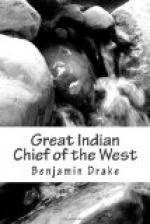The civil polity of these two tribes bears much resemblance to that of the north western Indians generally. The peace chiefs are partly elective and partly hereditary. The son succeeds the father by the assent of the tribe, if worthy of the office, and if not, a successor, of a more meritorious character, is chosen by them from some collateral branch of the family. There is a legend among them relating to the relative rank of their chiefs, which, although perhaps purely figurative, may not be uninteresting to the reader. They say that a great while ago, their fathers had a long lodge, in the centre of which were ranged four fires. By the first fire stood two chiefs, one on the right, who was called the great Bear, and one on the left, called the little Bear: these were the village or peace chiefs: they were the rulers of the band, and held the authority corresponding to that of the chief magistrate. At the second fire stood two chiefs: one on the right, called the great Fox, and one on the left, called the little Fox: these were the war chiefs or generals. At the third fire stood two warriors, who were called respectively the Wolf and the Owl. And at the other fire, two others who were the Eagle and the Tortoise. These four last named were not chiefs but braves of distinction, who held honorable places in the council, and were persons of influence in peace and in war. This lodge of four fires may have existed among these tribes. It is true that their chiefs remain as described in the legend.
The peace chief or head-man presides in council, and all important public acts are done in his name; but unless he be a man of popular talents and great energy of character his place confers more of honor than power. If a weak or irresolute man, although he nominally retain his authority, the war chiefs actually exercise it. It is very seldom that he acquires property, for he is expected to make feasts and presents, and is compelled to be hospitable and liberal as a means of sustaining his power among his people.




